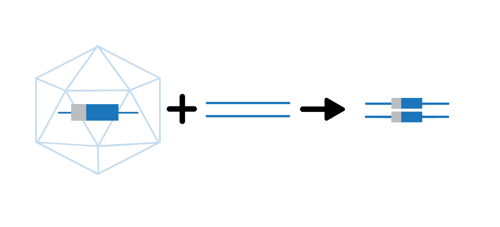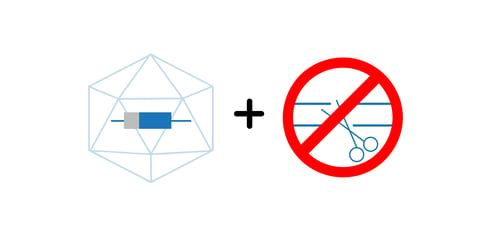Guest blogger Todd Waldman, Professor at Georgetown University, contributed to this post.

Adeno-associated viruses (AAVs) make fantastic gene delivery vehicles for episomal gene expression and are particularly useful for gene delivery to the nervous system. For many years they have also been used to enhance the efficiency of genome editing. In this post we'll walk through a variety of ways you can use AAVs to improve your genome editing experiments (with and without targeted nucleases).
AAV genome editing without a nuclease

Although the mechanism of incorporation is not well understood, researchers have been using AAV vectors for gene editing in mammalian cells since 1998. In that year, Russell and Hirata from the University of Washington reported a surprising finding - when delivered via AAV infection, gene targeting vectors with relatively short (1 kb) homology arms underwent homologous recombination at a frequency three orders of magnitude higher than identical targeting vectors delivered through transfection of naked DNA. Other investigators who had been working to develop high efficiency gene targeting approaches improved on this finding with the addition of selectable markers that are only expressed when the targeting vector is inserted downstream of a functional promoter (gene traps). The resultant gene targeting system could be used to routinely deliver sequences of interest to cells with efficiencies of 1-40% after G418 selection (Kohli et al 2004, Kim et al 2008). While the biology behind this AAV effect remains unclear, it is likely not a coincidence that the AAV genome is composed of single stranded DNA, which is particularly well suited for strand invasion, a key step in the homologous recombination pathway.
The Waldman lab at the Georgetown University School of Medicine has used this gene editing system frequently over the past fifteen years. Some examples from their lab include using AAV to introduce epitope tags into the endogenous alleles of the p53 and PTEN tumor suppressor genes in human cells (Kim et al 2008). They have also used AAV gene editing to introduce naturally occurring cancer-causing mutations into the endogenous allele of the STAG2 tumor suppressor in human cells (Kim et al, 2016).
The Waldman lab has designed their AAV tagging vectors (pAAV-SEPT-Acceptor and pAAV-TK-Acceptor) so that they can be easily adapted to edit your gene of choice. These vectors are very similar, both with polylinkers for the addition of gene-specific 1 kb homology arms flanking a FLOXed neoR gene. pAAV-SEPT-Acceptor, the preferred vector, contains a promoterless splice acceptor-IRES-neoR gene, which enhances the efficiency of homologous integration via gene trap enrichment, whereas pAAV-TK-Acceptor has a conventional heterologous promoter-driven TK-neoR gene.
To modify these tagging vectors for your specific gene, the lab recommends designing homology arms with the modification of interest, ordering them from a gene synthesis company such as IDT or Genscript, and cloning them sequentially into the chosen acceptor vector. The vectors are then packaged into AAV virions via transient transfection of 293T cells with helpers, and used to infect recipient cells. After G418 selection, individual gene edited clones are identified by PCR. Then, if necessary for subsequent experiments, the floxed neoR gene is removed via infection with adeno-cre.
AAV-based gene editing compared to CRISPR editing
CRISPR, of course, has started a revolution in gene editing. However, while CRISPR is remarkably effective for introducing non-sequence specific frameshift mutations through aberrant double strand break repair, it has proven more challenging to develop high efficiency CRISPR-based approaches for the generation of knockins via homologous recombination with a homologous repair template. It is this application - the creation of sequence-specific knockins - for which the AAV approach is most well suited, since it routinely generates knockin efficiencies of 1-40% with G418-selected clones.
However, there are important disadvantages to the AAV-based approach that must be considered when deciding whether to use AAV or CRISPR for a given experimental approach. First, unlike CRISPR, the AAV-based approach is only able to target a single allele of a single gene at once. Therefore, applications that require simultaneous modification of all alleles of a gene, or which require modifying multiple genes simultaneously in the same cell, are more appropriate for a CRISPR-based approach. Second, the AAV preps generally used for gene editing are low titre, and are therefore able to infect only a small subset of the cells used in a given experiment. For this reason, the AAV-based approach requires G418 selection of infected clones, making it unsuitable for most in vivo applications. Third, even in the most optimized tissue-culture based system, the efficiency of gene editing is occasionally less than 1%, and virtually never exceeds 40%. While this is comparable or better than the efficiency of most current CRISPR-based approaches for the generation of knockins, it is not always ideal. Because of these limitations, the AAV approach is best suited for tissue culture based approaches that require modification of only a single allele of a gene, such as the introduction of heterozygous endogenous epitope tags, or the introduction of dominant mutations of a gene into the endogenous allele in cultured cells.
AAV genome editing combined with targeted nucleases

In an effort to combine the respective advantages of the AAV and CRISPR-based approaches, several groups have recently worked to enhance the efficiency of AAV-based gene editing via the introduction of a double strand break by using a targeted nuclease. Asuri et al, for example, used zinc fingers to increase the efficiency of AAV mediated genome editing in human ESCs and iPSCs from ~0.2% to ~1.5%. In more recent work, researchers have combined AAVs with CRISPR systems. Ohmori et al 2017 use a dual vector system composed of SaCas9 and a gRNA in one AAV and a repair template in second a second AAV to deliver their repair template to mouse zygotes and thereby correct a mutation that causes Hemophilia B.
Unfortunately, work combining CRISPR with AAVs for improved genome editing is hampered by the fact that even small Cas9 homologs like SaCas9 and their requisite gRNAs take up essentially all of an AAV’s ~4.5 kB packaging capacity. Luckily, researchers have devised methods to deliver CRISPR components as ribonucleoproteins (RNPs) that can be supplied separately from the viral vector. This delivery method frees up space in the AAV allowing a researcher to fill it with the repair template.
Bok and Porteus 2017 recently showed that by delivering CRISPR components as RNPs and delivering two halves of a repair template spread across two AAVs, it is possible sequentially repair a target site with the contents of the two AAVs. Using this technique, Bok and Porteus deliver a repair template that would take up ~6.5 kB if delivered in a single AAV. They report roughly 40% repair efficiency in the K562 leukemia cell line and ~8 and 9% efficiencies in T-cells and hematopoietic stem cells respectively. Future researchers could apply this technique to efficiently deliver large repair templates for applications that require large gene fusions. The current state-of-the-art in combining the AAV and CRISPR-based approaches is described in several recent reviews (Howes and Schofield, 2015; Moser and Hirsch, 2016; Epstein and Schaffer, 2017)
Hopefully you’ve been able to check out some of the many applications of AAV in some of our other blog posts and have also been able to browse some of the ready to use AAV available through our viral service. In addition to being the vector of choice for gene delivery to a variety of cell types, now you know that AAVs can provide a powerful boost to genome editing experiments. We’re excited to see how you continue to use and develop AAVs for your own research and encourage to deposit any new AAV tools you create.
Many thanks to our guest blogger, Todd Waldman!
 Todd Waldman is a Professor of Oncology at the Lombardi Comprehensive Cancer Center, Georgetown School of Medicine. His research currently focuses on determining the mechanisms and consequences of cohesin gene inactivation in human cancer.
Todd Waldman is a Professor of Oncology at the Lombardi Comprehensive Cancer Center, Georgetown School of Medicine. His research currently focuses on determining the mechanisms and consequences of cohesin gene inactivation in human cancer.
References
1. Russell, David W., and Roll K. Hirata. "Human gene targeting by viral vectors." Nature genetics 18.4 (1998): 325. PubMed PMID: 9537413. PubMed Central PMCID: PMC3010411.
2. Kohli, Manu, et al. "Facile methods for generating human somatic cell gene knockouts using recombinant adeno‐associated viruses." Nucleic acids research 32.1 (2004): e3-e3. PubMed PMID: 14704360. PubMed Central PMCID: PMC373311.
3. Kim, Jung-Sik, et al. "Epitope tagging of endogenous genes in diverse human cell lines." Nucleic acids research 36.19 (2008): e127-e127. PubMed PMID: 18784188. PubMed Central PMCID: PMC2577350.
4. Kim, Jung-Sik, et al. "Intact cohesion, anaphase, and chromosome segregation in human cells harboring tumor-derived mutations in STAG2." PLoS genetics 12.2 (2016): e1005865. PubMed PMID: 26871722. PubMed Central PMCID: PMC4752446.
5. Asuri, Prashanth, et al. "Directed evolution of adeno-associated virus for enhanced gene delivery and gene targeting in human pluripotent stem cells." Molecular Therapy20.2 (2012): 329-338. PubMed PMID: 22108859. PubMed Central PMCID: PMC3277219.
6. Ohmori, Tsukasa, et al. "CRISPR/Cas9-mediated genome editing via postnatal administration of AAV vector cures haemophilia B mice." Scientific Reports 7.1 (2017): 4159. PubMed PMID: 28646206. PubMed Central PMCID: PMC5482879.
7. Bak, Rasmus O., and Matthew H. Porteus. "CRISPR-mediated integration of large gene cassettes using AAV donor vectors." Cell reports 20.3 (2017): 750-756. PubMed PMID: 28723575. PubMed Central PMCID: PMC5568673.
8. Howes, Rob, and Christine Schofield. "Genome engineering using adeno-associated virus (AAV)." Chromosomal Mutagenesis. Humana Press, New York, NY, 2015. 75-103. PubMed PMID: 25408402.
9. J Moser, Rachel, and Matthew L Hirsch. "AAV vectorization of DSB-mediated gene editing technologies." Current gene therapy 16.3 (2016): 207-219. PubMed PMID: 27280971.
10. Epstein, Benjamin E., and David V. Schaffer. "Combining engineered nucleases with adeno-associated viral vectors for therapeutic gene editing." Precision Medicine, CRISPR, and Genome Engineering. Springer, Cham, 2017. 29-42. PubMed PMID: 29130152. PubMed Central PMCID: PMC5702533.
Additional Resources on the Addgene Blog
- AAV: A Versatile Tool for Gene Expression in Mammals
- AAV Titers: Where do they come from and what do they mean?
- A Match Made in Heaven: CRISPR and AAV
Resources on Addgene.org
- Check out our Viral Service
- Find AAV Vectors
- Browse all Viral Vectors
Topics: Viral Vectors, AAV






Leave a Comment